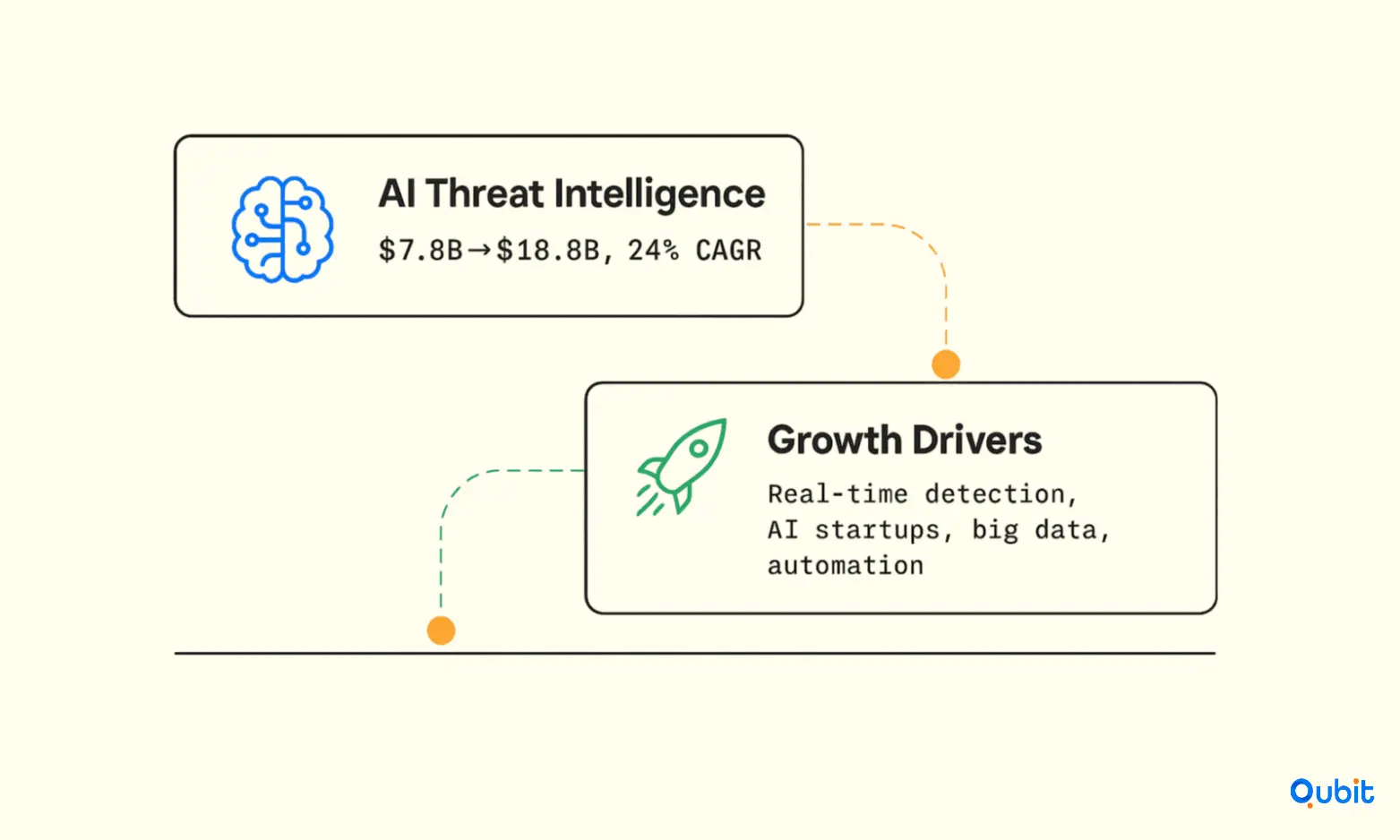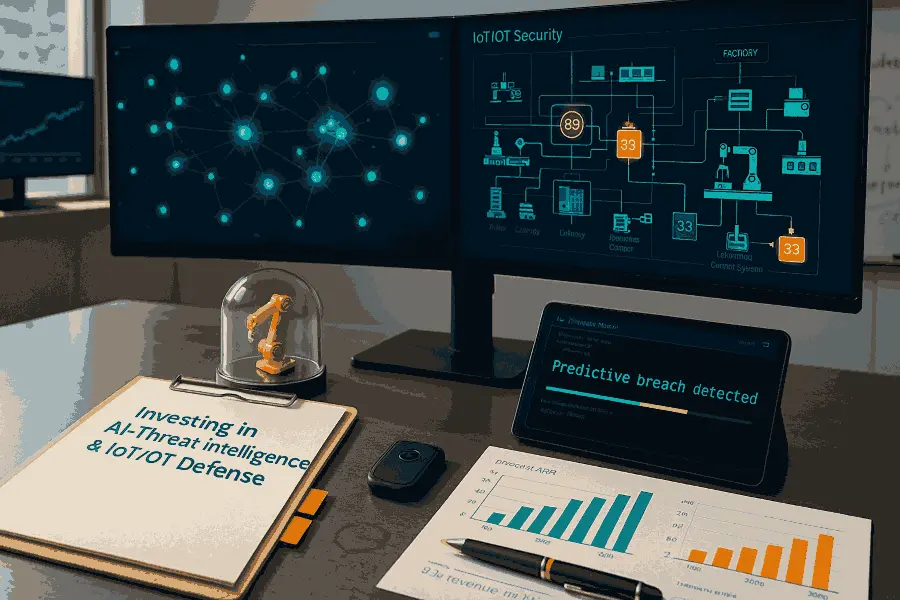The convergence of artificial intelligence (AI) and the expanding universe of IoT/OT (Internet of Things/Operational Technology) has fundamentally reshaped the cybersecurity landscape. As digital transformation accelerates across industries, organizations face an unprecedented wave of threats targeting both digital and physical infrastructure. This dynamic has fueled surging investor demand for AI-driven threat intelligence and advanced IoT/OT security solutions. For founders, investors, and technology leaders, understanding the market trajectory, investment trends, and success factors is essential for capitalizing on these opportunities.
This in-depth guide explores the growth drivers, funding landscape, investor expectations, and actionable strategies for those looking to invest in or build the next generation of AI-powered threat intelligence and IoT/OT security platforms.
Market Growth & Opportunity: Why AI and IoT/OT Security Are Hot
AI-Driven Threat Intelligence: Explosive Growth

The AI-driven threat intelligence market is experiencing exponential expansion. According to recent reports, the market is valued at $7.87 billion in 2025 and is projected to reach $18.82 billion by 2029, representing a 24.4% CAGR. This remarkable growth is attributed to:
- The increasing demand for real-time, predictive threat detection.
- The proliferation of AI-powered cybersecurity startups.
- The growing availability of big data and advanced analytics for threat intelligence.
- The rising adoption of automated patch management and edge computing.
The broader threat intelligence market (including traditional and AI-driven solutions) is also booming, growing from $12.06 billion in 2024 to $13.56 billion in 2025 at a 12.4% CAGR, and forecasted to reach $26.19 billion by 2029. This surge is driven by advanced persistent threats, IoT security challenges, zero trust security models, and the need for collaborative threat intelligence sharing.
IoT/OT Security: Critical Infrastructure in the Crosshairs
The expansion of IoT and OT devices has created new attack surfaces for cybercriminals. Industrial, healthcare, energy, and manufacturing sectors are especially vulnerable, with attacks on critical infrastructure rising sharply. Key growth drivers for IoT/OT security include:
- The explosion of connected devices in industrial and enterprise environments.
- The need to secure legacy OT systems alongside modern IoT deployments.
- Regulatory mandates (e.g., NIS2, DORA) requiring robust security for critical infrastructure.
- Increased investment in segment-specific cybersecurity solutions for BFSI, healthcare, and manufacturing.
Investor Appetite and Capital Flows
Record-Breaking Investment in AI & Threat Intelligence
Investor interest in AI-driven threat intelligence is at an all-time high. In Q1 2025 alone, AI and ML startups secured $73.6 billion across 1,603 deals, with a significant portion directed toward cybersecurity and threat intelligence platforms. Dedicated AI venture funds, such as Boldstart Ventures’ $250 million AI fund, are targeting early-stage innovators in this space.
Notably, mega-rounds like ReliaQuest’s $500 million raise for its agentic AI-driven cybersecurity platform highlight the scalability and venture appetite for these technologies.
IoT/OT Security Funding: A Rising Priority
The IoT/OT security segment is attracting robust early and growth-stage capital. Over half of deals to connected enterprise security startups occur at the seed or Series A stage, reflecting strong investor belief in the long-term potential of securing industrial and operational environments. Corporate venture arms of hyperscalers, industrial conglomerates, and technology vendors are increasingly active, seeking both strategic advantage and financial return.
Geographic and Sectoral Trends
- North America and Europe lead in both AI-driven threat intelligence and IoT/OT security investment, driven by regulatory mandates and high enterprise adoption.
- Asia-Pacific is emerging as a growth region, fueled by rapid industrialization and digital adoption.
- Key verticals: BFSI, healthcare, manufacturing, and energy are the most active sectors for both investment and adoption.
For more on sector-specific funding trends, see our funding landscape for IoT/OT security startups in 2025.
Technology Trends Shaping Investment Decisions
AI-Driven Threat Intelligence: Key Innovations
- Predictive Analytics & Real-Time Detection: AI models process vast data streams to identify threats before they materialize, enabling proactive defense.
- Automated Patch Management: AI-driven platforms can autonomously identify vulnerabilities and deploy patches, reducing response times and human error.
- Edge Computing Integration: AI-powered threat intelligence is increasingly deployed at the edge, securing devices and data closer to the source.
- Agentic & Generative AI: Next-generation platforms use agentic AI for autonomous decision-making and generative AI for simulating attack scenarios and improving threat models.
IoT/OT Security: Innovations and Challenges
- Zero Trust Security Models: Segmentation and continuous verification are now standard for IoT/OT environments, reducing lateral movement and exposure.
- Collaborative Threat Intelligence: Platforms that facilitate sharing of threat data across organizations and sectors are gaining traction.
- Legacy System Integration: Solutions that can secure both modern IoT and legacy OT systems are highly valued.
- Automation & Orchestration: Automated incident response and orchestration tools are critical for scaling security across distributed environments.
What Investors Look For: Key Metrics & Success Factors
Financial Metrics
- ARR Growth: Investors expect 2x or higher year-over-year ARR growth for AI and IoT/OT security startups.
- ARR Multiples: High-growth companies command 8x–15x ARR multiples, with premiums for those serving regulated or critical infrastructure sectors.
- Gross/Net Retention: >90% gross and >110% net retention are best-in-class for SaaS security platforms.
Customer & Product Metrics
- Enterprise Logo Acquisition: Landing Fortune 500 or regulated industry clients signals strong market fit.
- Churn Rate: <5% is ideal, especially for mission-critical security solutions.
- Pilot-to-Paid Conversion: >30% conversion from pilot to paid contract demonstrates product-market fit.
- Integration Breadth: Ability to support cloud, edge, on-prem, and hybrid environments is a differentiator.
Technical Differentiation
- AI Model Performance: Precision, recall, and adaptability of threat detection models.
- Scalability: Platforms must handle billions of daily events and support global deployments.
- Compliance Readiness: Certifications (SOC 2, ISO 27001) and regulatory alignment are increasingly required.
For more on investor criteria, see our investor demand for AI-driven threat-intelligence platforms.
Go-to-Market Strategies: Scaling and Differentiation
Compliance-Driven Adoption
AI and IoT/OT security platforms that automate compliance with GDPR, NIS2, DORA, and industry mandates are especially attractive. Automated audit trails, access governance, and real-time reporting are now essential features for enterprise buyers.
Multi-Cloud, Edge, and Hybrid Integration
Modern enterprises operate across public clouds, private clouds, edge devices, and legacy OT systems. Platforms that offer seamless integration and unified management across these environments are in high demand.
AI-Driven Observability and Automated Response
With the rise of shadow IT, machine-to-machine identities, and AI-powered attacks, real-time observability and automated response are critical. Investors favor startups that use AI to deliver continuous monitoring, anomaly detection, and rapid incident response.
Strategic Partnerships and Ecosystem Plays
Co-selling with hyperscalers, integrating with leading SIEMs and EDRs, and forming alliances with industrial vendors can accelerate customer acquisition and de-risk go-to-market execution.
Alternative Funding Channels & Strategic Partnerships
Corporate Venture Capital & Strategic Investors
Corporate VCs from hyperscalers, industrial conglomerates, and security vendors provide not just capital but also distribution, technical validation, and access to enterprise customers.
Revenue-Based Financing and Government Grants
Non-dilutive funding options, such as revenue-based financing and government grants—are increasingly popular for AI and IoT/OT security startups, particularly those with predictable MRR or those innovating in critical infrastructure.
Crowdfunding and Community-Driven Investment
For early-stage and B2C-focused security startups, equity and rewards-based crowdfunding can provide both capital and a loyal user base.
Case Studies: Success Stories in AI Threat Intelligence & IoT/OT Security
ReliaQuest (US, 2025)
- Raised: $500M mega-round to expand its agentic AI-driven cybersecurity platform.
- What Worked: Autonomous threat detection, rapid scaling, and strong partnerships with cloud and enterprise vendors.
Claroty (Israel/US, 2025)
- Focus: OT/IoT security for industrial and healthcare sectors.
- Funding: Series D round led by SoftBank and Bessemer, raising $140M+.
- Success Factors: Deep integration with legacy OT, compliance automation, and robust ecosystem partnerships.
Dragos (US, 2024)
- Specialty: Industrial cybersecurity for energy and manufacturing.
- Funding: $200M+ in cumulative funding.
- Differentiation: AI-driven threat intelligence, incident response, and a platform trusted by critical infrastructure operators.
Future Trends: Where the Market Is Headed
Agentic and Generative AI
Autonomous, self-learning AI systems will become standard for threat detection, response, and simulation, reducing human intervention and improving speed.
Federated Learning and Collaborative Defense
Privacy-preserving AI models and collaborative threat intelligence sharing will enable organizations to defend collectively without exposing sensitive data.
Edge & 5G Security
As edge computing and 5G networks proliferate, AI-driven security platforms capable of real-time, distributed protection will be essential.
Regulatory Evolution
New regulations will continue to raise the bar for security, privacy, and resilience, driving investment in compliant, future-proof solutions.
Actionable Strategies for Investors and Founders
- Benchmark against top performers: Track ARR growth, retention, and technical differentiation.
- Prioritize compliance and integration: Ensure your platform automates compliance and supports multi-cloud/edge/OT environments.
- Leverage strategic partnerships: Engage with hyperscalers, industrial vendors, and SIEM/EDR providers.
- Invest in AI innovation: Focus on explainability, adaptability, and performance of AI models.
- Prepare for due diligence: Maintain a clean data room, robust documentation, and clear metrics.
- Explore alternative funding: Consider revenue-based financing, government grants, and CVCs for non-dilutive capital and strategic support.
Conclusion
The intersection of AI and IoT/OT security represents one of the most dynamic and lucrative opportunities in cybersecurity today. As threats become more sophisticated and digital and physical worlds converge, investors and founders who understand the evolving landscape, prioritize compliance and integration, and innovate with AI will be best positioned for success.
Use our Fundraising Assistance service to get expert, industry-aware support that helps you build a compelling narrative, engage the right backers, and close rounds with confidence.
Key Takeaways
- AI-driven threat intelligence and IoT/OT security are among the fastest-growing cybersecurity segments, with double-digit CAGR and surging investor demand.
- Investors prioritize rapid ARR growth, strong retention, and technical differentiation, especially in regulated and critical infrastructure sectors.
- Compliance, integration, and AI-driven automation are essential for market success.
- Alternative funding channels and strategic partnerships can accelerate growth and de-risk scaling.
- **Future trends—agentic AI, federated learning, edge security—will define the next wave of innovation and investment.
Frequently asked Questions
How big is the AI-driven threat intelligence market in 2025?
The market is valued at $7.87 billion in 2025 and projected to reach $18.82 billion by 2029, growing at a 24.4% CAGR


 Back
Back



